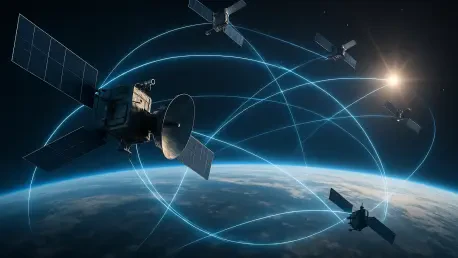In a striking display of technological prowess, China has unleashed a remarkable wave of satellite launches this September, cementing its position as a formidable force in the global space arena, with each mission enhancing its infrastructure for economic growth, national security, and international influence. This surge of activity is not merely about placing hardware into orbit; it represents a calculated strategy to dominate critical areas such as broadband internet, environmental monitoring, and innovative connectivity solutions. With each mission, China is challenging established players and setting new benchmarks in space exploration. From ambitious megaconstellations aimed at rivaling Western services to advanced weather satellites contributing to global data, these efforts reveal a nation determined to shape the future of space technology. As the launch cadence accelerates, the implications of this rapid expansion ripple across geopolitical and commercial landscapes, raising questions about competition and collaboration in the final frontier.
Building Global Connectivity with Broadband Satellites
The cornerstone of China’s recent space achievements lies in the aggressive expansion of the Guowang broadband megaconstellation, designed to compete directly with global satellite internet giants. With an ultimate goal of deploying nearly 13,000 satellites in low Earth orbit (LEO), and a shorter-term target of 400 by 2027, this initiative blends commercial opportunity with strategic intent. A significant milestone came on September 27, when a Long March 6A rocket carried another batch of Guowang satellites into space, potentially increasing the total in orbit to 86. This rapid deployment, marked by seven missions in just the preceding two months, underscores an urgency to establish a robust presence in the satellite internet market. Beyond mere numbers, the project reflects a broader ambition to provide high-speed connectivity across underserved regions, positioning China as a key player in bridging the global digital divide while also securing communication channels for national interests.
Complementing this technological push is the evident determination to match or surpass international competitors in both scale and speed. The Guowang constellation is not just about connectivity; it serves as a statement of technological sovereignty, reducing reliance on foreign systems and enhancing domestic capabilities. Each launch builds momentum toward a network that could redefine how internet access is delivered worldwide, particularly in remote or geopolitically sensitive areas. Moreover, the project’s accelerated timeline suggests a synergy between state-driven goals and industrial capacity, enabling a pace that few other nations can currently match. As this constellation grows, it also raises important considerations about space traffic management and the sustainability of such large-scale orbital deployments, challenges that will need addressing as the network expands further.
Pioneering IoT Networks for Commercial Innovation
Another remarkable stride in China’s space agenda is the completion of the initial phase of the Geesatcom IoT constellation, operated by Geespace, a subsidiary of the automotive giant Geely. On September 24, a Jielong-3 solid rocket launched 12 satellites from a mobile sea platform, finalizing a 64-satellite network that delivers low-bandwidth connectivity for devices across multiple regions. This system lays the groundwork for applications ranging from logistics to smart infrastructure, with future plans envisioning a massive 5,000-satellite expansion to include broadband services. Backed by a recent $281 million investment, the project highlights China’s commitment to integrating space technology into everyday commercial sectors. This constellation’s focus on the Internet of Things (IoT) represents a forward-thinking approach to connectivity, aiming to support emerging technologies that depend on seamless, global data exchange.
The implications of the Geesatcom network extend beyond immediate connectivity, pointing to a strategic vision for industries like autonomous driving, where precision navigation is critical. By linking space-based systems with terrestrial innovations, China is fostering an ecosystem where vehicles, factories, and cities can operate with unprecedented efficiency and coordination. This initiative also showcases a unique blend of public and private enterprise, as commercial entities like Geespace collaborate with state resources to drive technological progress. Such partnerships accelerate development and bring diverse expertise to the table, ensuring that the constellation evolves to meet both current demands and future challenges. As this network scales, it could redefine how industries leverage satellite technology, setting a precedent for other nations to follow in merging space capabilities with ground-based innovation.
Strengthening Environmental Oversight from Orbit
China’s dedication to global environmental challenges is vividly demonstrated through the launch of the Fengyun-3H weather satellite on September 26, utilizing a Long March 4C rocket. Weighing 2,300 kilograms and orbiting in a polar trajectory, this advanced satellite is equipped with nine instruments to monitor a wide array of phenomena, including weather patterns, ocean conditions, atmospheric chemistry, and space weather. This capability significantly enhances China’s capacity to predict natural disasters and respond effectively, safeguarding lives and infrastructure. Additionally, the data collected contributes to international efforts in climate monitoring and disaster preparedness, aligning with global priorities to address environmental crises. Such missions emphasize China’s role not just as a competitor in space but also as a collaborator on pressing planetary issues.
The deployment of Fengyun-3H also reflects a meticulous approach to building a comprehensive meteorological infrastructure that supports both national and international needs. By gathering detailed insights into climate dynamics and environmental changes, the satellite aids in refining models that predict long-term trends, offering valuable information for policymakers and scientists alike. This focus on environmental stewardship through space technology underscores a broader commitment to sustainable development, balancing technological advancement with ecological responsibility. Furthermore, the mission’s success highlights the reliability and precision of China’s launch systems, reinforcing confidence in its ability to execute complex scientific endeavors. As more such satellites join the fleet, the cumulative impact on global weather forecasting and climate research could be transformative, fostering greater resilience against environmental uncertainties.
Exploring New Frontiers in Internet Solutions
China’s space program is also venturing into uncharted territory with experimental satellite internet technology, as evidenced by a Long March 2C rocket mission on September 15 that placed four satellites into orbit. Positioned at an altitude of 800 kilometers, these satellites are believed to be testing innovative connectivity solutions, potentially linked to the broader Guowang initiative. Collaborations between state-owned entities and commercial firms signal a dynamic and adaptive strategy, focusing on cutting-edge applications like direct-to-device services. Supported by recent policy measures, this experimental approach demonstrates a willingness to push technological boundaries, ensuring that China remains at the forefront of the rapidly evolving space industry while addressing future demands for seamless communication.
These exploratory missions are a testament to China’s proactive stance in anticipating the next wave of connectivity needs, particularly in a world increasingly reliant on instant, ubiquitous access to data. By testing novel technologies, the country is laying the foundation for solutions that could bypass traditional infrastructure, offering internet access directly to individual devices regardless of location. This forward-looking perspective not only enhances national capabilities but also positions China as a potential leader in defining how global communication networks operate in the coming years. The involvement of both public and private sectors in these experiments further accelerates innovation, creating a fertile ground for breakthroughs that could reshape user experiences worldwide. As results from these tests emerge, they may herald a new era of connectivity, challenging existing paradigms and opening up fresh opportunities for global interaction.
Reflecting on a Milestone in Space Achievement
Looking back, the series of launches in September marked a pivotal chapter in China’s journey toward becoming a space superpower, with missions that expanded broadband access, completed IoT networks, advanced weather monitoring, and tested groundbreaking internet technologies. Each endeavor showcased a blend of ambition and precision, reflecting a national strategy that prioritized both immediate impact and long-term vision. The high frequency of launches, nearing record-breaking numbers for the year, underscored a relentless drive that few could rival. Moving forward, the focus should shift to sustainable practices in orbit, ensuring that such rapid expansion does not compromise space safety or accessibility. International dialogue and cooperation will be crucial in managing shared challenges like orbital debris, while continued investment in innovation promises to keep China at the forefront of space exploration and application.









